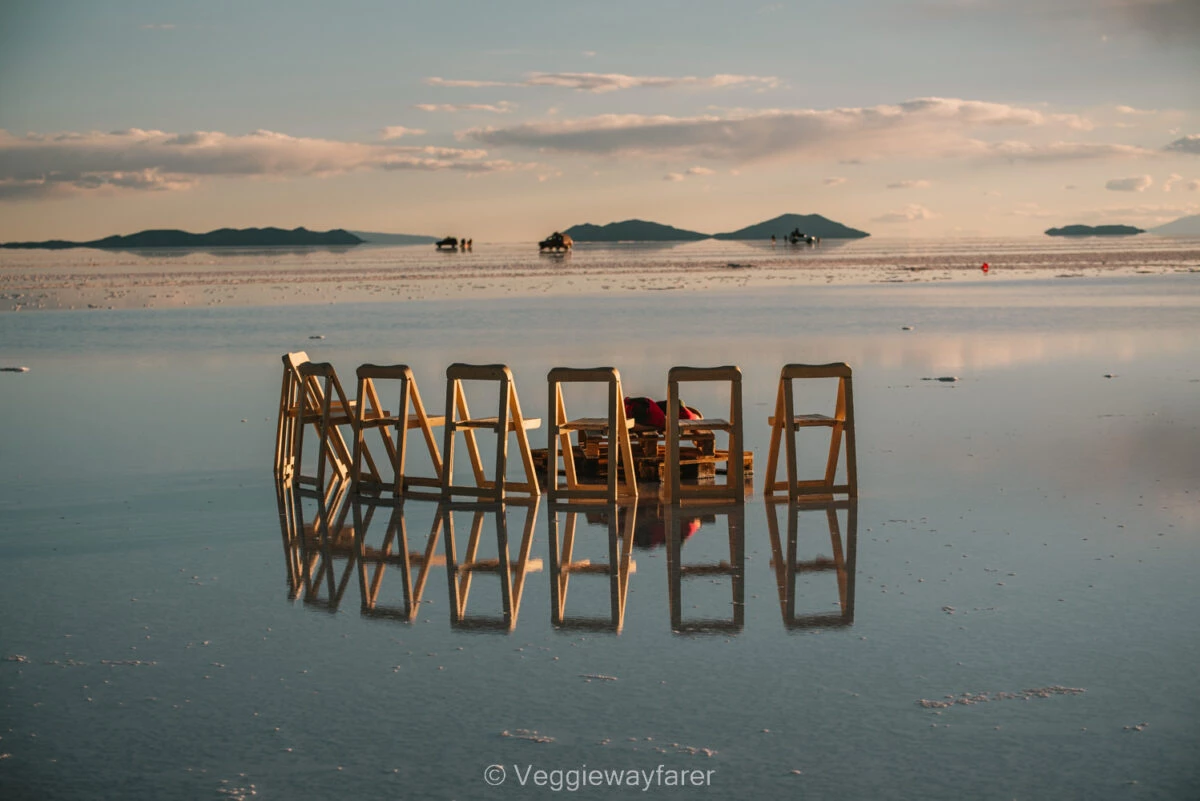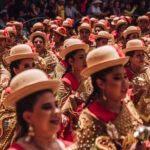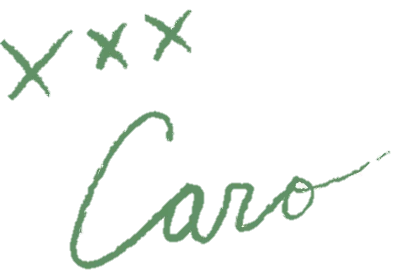As rainy season settles over the Bolivian salt flats, they transform into the world’s largest mirror. The edges of the horizon blur and the sound of crunching salt underfoot gives way to the splashing of water. Experience the Salar de Uyuni mirror effect for yourself with below practical tips & tidbits of information.
The white expanse of the Uyuni Salt Flats, Salar de Uyuni, is a sight to behold. At a staggering altitude of 3,656 meters (11,995 feet), it will take your breath away, in just about every sense of the word. While the Salar is a “must-see” yearlong, the reflective salt flats can only be experienced from December to March
Heading into the Salt Flats can be done with or without a guide, a plethora of options exist to accommodate just about every budget and timeframe. As our trip to Bolivia was limited in time, we chose to take a (very full) one-day excursion which included lunch, drinks and even star gazing. Time to delve into the Salar de Uyuni information and plan your trip!
Please note: This post contains affiliate links, meaning I may earn a commission if you make a purchase by clicking a link (at no extra cost to you). Learn more.


Quick planning guide for the Bolivian Salt Flats
SALT HOTELS IN UYUNI
- Luxury pick: Hotel Palacio de Sal
- Where we stayed: Hotel Cristales De Sal
- Top rated: Casa de Sal
- See all accommodations
THINGS TO DO
- Top rated (group): 3-Day Uyuni Tour
- Top rated (private): 3-day Private Uyuni Tour
- Budget-friendly: Day Tour Uyuni (incl. lunch)
- Bolivia+Chile: Uyuni & Atacama in 3 days
TOURS FROM LA PAZ: A few tour operators run direct tours from La Paz to Uyuni. A one-day Uyuni tour is available or a 3-day Uyuni tour. Tours depart and end in La Paz. Bus tickets, food and accommodation are included in the price.
WHAT TO PACK: Sunscreen (lots of it), a set of warm clothes, an extra SD card for your camera, sturdy footwear that can withstand salt, sunglasses, and a hat if you have one.
Where is the Salar de Uyuni
The impressive Salt Flats are located in the southwestern part of Bolivia, roughly 500 kilometers from the capital La Paz and a mere 300 kilometers from the San Pedro de Atacama desert in Chile.
Nestled within the Andean Altiplano at an airy 3,656 meters (11,995 feet high), the Salar de Uyuni is not only the largest salt flat in South America but in the world, coming in at a whopping 8000 square kilometers (3,100 square miles).
Safety first: The sheer size of the Salar combined with the endless stretches of uniform off-white landscapes make navigating a herculean effort, especially during rainy season. Tracking down the reflective salt flats and knowing which pools of water are safe to drive through requires an intimate knowledge of the area. Don’t risk it and take a tour instead!


Salar de Uyuni facts and legends
According to legend, the mountains surrounding the Bolivian salt flats were once giant people. Many a tale has been spun about the origins of the Salar, they seem to have one thing in common, the protagonist is seemingly always a heartbroken mother.
According to Aymaran legend, the goddess Tunupa was left by her husband Kusku while breastfeeding their child. Her tears and breastmilk mingled creating the Salar de Uyuni. Another popular tale speaks of the mountain goddess Yana Pollera sending her child away as two suitors (Thunupa and Q’osqo) fight over paternity. She floods the plain with milk to ensure the child has enough to eat.
As enticing as these fables are, the true facts about the Salar de Uyuni and how it came to be might be even more interesting. Thirty thousand years ago, the Salar was an enormous lake. Altitude and arid air evaporated the water, leaving behind a thick crust of salt beneath which lies 70% of the world’s Lithium reserves, a crucial building block in electric batteries.
As demand for rechargeable batteries grows, so does the need for Lithium. When we recently visited, it was confirmed to us by government officials that the previously halted plans to build Lithium factories had been approved. What this means for the future of the Bolivian Salar de Uyuni is anyone’s guess.

Best time to see the Uyuni Salt Flat mirror
So what is the best time to visit the Salar de Uyuni? In Bolivia, the rainy season runs from December to March. If the name of the game is reflections then bookmark these months to plan your visit. It is noteworthy to mention that the Uyuni salt flats mirror effect is only visible if there is enough rainfall that specific year!
When did we go: I strongly recommend you time your visit to Bolivia to coincide with Carnival. Four days before Lent (usually in February), the streets of every major city erupted into a frenzy of street parties, foam fights and locals dressed up in traditional costumes. We partook in the UNESCO-classified Oruro Carnival right before visiting Uyuni.
Good to know: If you are planning on visiting other parts of Bolivia, the rainy season can interfere with your travel plans especially in and around the Amazon where flooding is frequent. That being said aside from a lot of mosquitos, we did not encounter any issues at all.
TIP: If you booked a day tour make sure it includes the option to rent rainboots + includes time to watch the sunset. The deep pink hues of the sky reflected in the mirror salt flats will make you feel like you are flying high atop fluffy clouds!
Is the Salar really worth it in rainy season ?
To give you the short answer: A resounding HECK YES!
The Salar de Uyuni is truly glorious and unlike anywhere else on this little planet we call Earth. A sublime expanse of hexagonal patterns spreading endless geometric perfection, occasionally interspersed by a lake or, more frequently, a flotilla of jeeps carrying snap-happy tourists.
It is therefore utterly astonishing how the addition of but a few centimeters of water can elevate the landscape from a ‘mere’ glorious to a truly divine. As the sun starts to set, our tour headed deeper into the Salar in search of the biggest mirror in the world.
The jeeps come to a halt and we are instructed to pull on our borrowed rainboots. As the crunch of salt underfoot makes way for the splashing of water, the boundaries between sky and earth blur. Walking feels like being enveloped in the soft embrace of pink billowing clouds. I have goosebumps just writing about the experience!

Salar de Uyuni tours to see the world’s largest mirror
What to expect when taking a tour of the Salar
The vast majority of tours will start and end in the town of Uyuni. Upon leaving Uyuni you will make two stops before getting to the Salar itself: The train cemetery and the village of Cochini, where the process of salt mining is explained.
Cochini has a little store where you can purchase amongst other things Uyuni Salt but also Alpaca sweaters (Bs 110) or – the much beloved picture prop – a poncho (Bs 170). When we went neither our credit or debit cards work, so if you are looking to purchase a souvenir make sure to bring local currency.
One-day versus three-day Salar de Uyuni Tours
One day tours
If you are just looking to get a first impression of the Salar itself and are short on time and/or budget than the one day tour is perfect. Most tours include lunch and a handful of tour operators will also include the sunset, which I highly recommend if you want to snap some truly awesome pictures with the reflections on the Salar.
TIP: If you book a one day tour, try and see if the tour operator is open to extending your excursion a bit to include not only the sunset but also star gazing. We were able to negotiate at no extra cost but I have heard from others this is not always the case.
Three day tours
If you have a bit more time on your hands and want to get a feel of not only the Salar but the surrounding colorful mineral lagoons with the famous Salar de Uyuni flamingos, arid desert, and picturesque rock valleys then three days is definitely worth it.
A quick calculation makes it clear that this tour offers the snap-happy visitors two extra sunsets and sunrises versus the one-day tour. It also gives you the option to go star gazing from the desert, as mentioned above this is not always possible in the one-day tours.
As we were short on time, we took the one-day tour. But I would love to come back during the rainy season one year and book an immersive three-day tour.
DO I NEED TO BOOK IN ADVANCE? There are plenty of Salar de Uyuni tour operators within the town of Uyuni. You can easily rock up and book your tour directly. If, like me, you do like booking everything in advance check out the highest-rated 3-day group tour or splurge and go for a 3-day private tour.


Salar de Uyuni at night
The Uyuni Salt Flats at night are catnip for amateur stargazers. Being far removed from civilization means the stars have the chance to light up the sky, without pesky interference from light pollution. Surprisingly we saw the first glimpse of the Milky Way about 15 minutes after sunset.
Watching the stars is not part of the standard day tour package. In fact, we got really lucky that our tour guide was a bit flexible and the stars came out very fast. The 3-Day Uyuni Tour has two nights in the desert which are dedicated to stargazing.
Recently specialized stargazing tours have popped up, these 3-hour tours usually leave from Uyuni at 08.00 pm and include transportation to the salt flats, a walk, and sometimes a bottle of wine.
PRACTICAL TIP: It gets really cold as the sun starts to set on the Salar de Uyuni. Bolivia by night in the desert requires a ton of layers of warm clothing. I was wearing a winter coat, wool sweater, hat, and scarf while lamenting not having bought gloves.
Where to stay in Uyuni
WHERE WE STAYED: Hotel Cristales De Sal (****/$$)
Located in the heart of Uyuni town, this midrange 4-star hotel had huge rooms, comfortable beds and nice hotel showers. The WIFI was strong and the staff was accommodating. Looks unassuming from the outside but really great value/money within Uyuni itself. Rated 9.1 on booking.com
WHERE I WISH WE STAYED: Hotel Palacio de Sal (*****/$$$$)
This is a truly iconic Salar de Uyuni hotel, located on the outskirts of the Salar. The hotel is a so-called “salt hotel” made up entirely of salt! What makes this splurge worth it is the rooms overlooking the Salar. Imagine enjoying your morning coffee while watching the sun rise over the Salar. EPIC! Rated 9 on booking.com
MIDRANGE SALT HOTEL: Casa de Sal (****/$$)
Want to stay in an iconic salt hotel but don’t feel like spending a huge budget? Casa de Sal is the top-rated mid-range salt hotel located in the heart of Uyuni town. Everything, including the beds, is made out of salt from the Salar. Make sure to check out the rooftop restaurant at sunset! Rated 9.2 on booking.com
How to get to the Salar de Uyuni
FLY FROM LA PAZ TO UYUNI
- Schedule: There are two direct flights a week between La Paz (LPB) and Uyuni (UYU). Flights from La Paz leave Wednesday and Sunday
- Airline: operated by Boliviana de Aviación (BOA).
- Flight time: Under one hour
- Price: Between US$60 – US$250 (one way) Check flights.
TAKE THE BUS FROM LA PAZ TO THE SALAR DE UYUNI MIRROR
- Schedule: The buses from La Paz to Uyuni depart daily at 07:00 pm and 10:00 pm. The latest departure is at 10:00 pm with Trans Titicaca
- Bus company: Trans Titicaca, Trans Omar, Panasur, Cruz del Norte, Cisne Bus Uyuni, Autobuses Emperador
- Length: Direct 9 hours, with stops 12 hours (onboard meals are included)
- Price: Starting at US$24. Check the schedule & prices.
TIP: Short on time? Try booking an overnight roundtrip from La Paz to Uyuni. Hop on a sleeper bus from La Paz to Uyuni, tour the Salar during the day and take the sleeper bus back to La Paz.


Budget to visit the Uyuni salt flats in Bolivia
Your Salar de Uyuni trip will not be the most budget-friendly part of your travels through Bolivia. Between the cost of getting there, accommodation and potential tour you are looking at at least US$200 per person – if you opt for hostel accommodations and a one-day tour.
SALAR DE UYUNI TOUR COSTS: Three-day tours cost between US$250-US$300; Day tours US$115. These costs are for group tours, if you would like to see the Salar de Uyuni mirror on a private tour the cost is upwards of triple the group tour costs.
ACCOMMODATION COSTS: Unless you are coming in with an overnight bus from La Paz, count on spending two nights in Uyuni e.g. the night before and after your tour. Accommodation in Uyuni starts at US$40 (hostels) and go up to US$360 (5-star hotels). We paid US$145 for our midrange accommodation.
ADDITIONAL COSTS: Getting to Uyuni can be done via overnight bus from La Paz (US$15-US$24 depending on the bus company) or flight (US$100). Prices indicated are one way.

How to make your Salar de Uyuni trip more sustainable
BUY LOCAL SOUVENIRS: One of the stops on the tours is Cochani. It has a handful of small shops where locally-made souvenirs can be purchased.
BOOK A TOUR: Why did we take a tour of the Uyuni Salt Flats? Bolivia is a very budget-friendly country, meaning the majority of tours are pretty solid value/money. Most tours leave from the little town of Uyuni which is heavily reliant upon tourism, so splurging a little for a tour is a great way to support the local economy.
LEAVE NO TRACE: Whatever you take into the Salar of Uyuni has to come back out with you regardless if you go on your own or with a guide.


Practicalities for exploring de Salar de Uyuni mirror effect
Weather
De Salar de Uyuni temperature fluctuates significantly from day to night. With highs of 15°C/59°F around midday and lows of 0°C/32°F at night. Please note these are the temperatures during the rainy season e.g. December to March when you can see the reflecting salt flat. If you visit later in the year temperatures tend to drop to 5°C/41°F and well below 0°C/32°F at night.
Altitude of the Bolivian Salt Flats
The Uyuni Salt Flats are located at an elevation of 3,600 meters (11,811 feet) above sea level. If you are not accustomed to the altitude make sure to drink a lot of water. What helped me a lot was chewing on coca leaves, ask your tour guide where to purchase them. Be mindful however that coca leaves are prohibited in many countries, so do not bring them back home with you!

What to pack when exploring the salt flats
PACK FOR THE COLD: You will need a daypack to visit the Uyuni Salt Flats. Bolivia tends to have a very moderate temperature in summer, the Salar is even chillier than most places so pack a lot of warm clothes (hats, gloves, sweaters, and thermals if you plan on spending the night). Make sure to also bring a pair of sturdy shoes as the salt is very corrosive.
PACK FOR THE SUN: Despite the cold, the sun is very strong at this altitude. Bring a lot of heavy-duty sunscreen (SPF30 and above) and a pair of good-quality sunglasses. The light reflects off the white salt which is exceptionally harsh for your eyes (comparable to when you go skiing).
PACK TO WALK IN THE WORLDS LARGEST MIRROR: Most tour operators will provide gumboots if you are visiting during rainy season. We only experienced a few centimeters of water but were told that in some places the water can get rather deep, in which case boots are needed.
PACK FOR PICTURES: Bring an extra power bank for your phone and pack a few extra batteries. The combination of altitude and cold will drain your batteries a lot faster than usual.

FAQ Salar de Uyuni Mirror
How were the Salar de Uyuni salt flats formed?
Thirty thousand years ago, the Salar was an enormous lake. Altitude and arid air evaporated the water and left behind a thick crust of salt that you see today.
Is it possible to visit the salt flats without a guide?
It is, however, if you want to head into the salt flats you will need to rent a 4WD for safety reasons. Head to the entrance of the Salar (on route 30 – the highway connecting La Paz to Uyuni) and pay 5 Bs.
Can you eat the salt from the Bolivian salt flats?
Yes, you can try some of the salt that is crunching under your feet just for laughs. The salt extracted from the Salar does not contain enough iodine for daily use and is therefore treated before being commercialized.
Reflective salt flats in Bolivia, an unmissable experience.
As we drove home from an action-packed day, faces lobster red (my kingdom for some aftersun!) and cameras overflowing with videos involving questionable dance moves, a dinosaur and an empty beer can, it dawned on me that this was probably the absolute highlight of my trip to Bolivia.
MORE TRAVEL RESOURCES FOR SOUTH AMERICA
Bolivia: Complete guide to Oruro Carnival
Bolivia: 10 Reasons why Bolivia is worth visiting
Bolivia: 15 Unmissable places to see in Bolivia
Bolivia: Practical guide to Chualluma La Paz
Bolivia: 13 Things to do in La Paz – A local’s guide to the capital of Bolivia
Argentina: Everything you need to know before planning a trip to Argentina
Argentina: Things to know before planning a trip to Patagonia
Chile: Three day Easter Island itinerary
South America: Carnivals in Latin America worth attending

Guide to Salar de Uyuni mirror effect: Pin It













The closest I got to the salt flats was Puramarca in Argentina. They are at lower altitudes but still awe-inspiring.